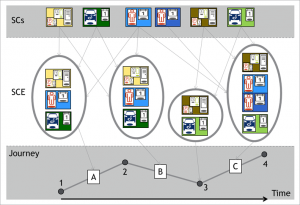Why is it useful to describe e-mobility using service component ensembles (SCE)?
Own Car versus Mobility Service
In a future e-mobility-scenario, it is assumed that many people don’t have their own cars. They will use vehicles temporally depending on their mobility needs. Why this assumption?
There are many of reasons for this development. All of these reasons are closely related to energy constraints and hence to the battery. The limited capacity of the battery leads to range limitation. The necessary charging time reduces the e-car availability. The high battery cost makes the car expensive and the life cycle of battery limits the time value of the vehicle. Through these arguments it can be seen that user will value mobility more than the e-vehicles itself.
Temporal Composition of Service Component Ensembles
From this point of view it is interesting to apply flexible service architectures for supporting the user. The scenario components “user” (blue colored in the figure) and “vehicle” (green colored) are no longer strongly connected in this e-mobility scenario. The scenario components are represented by their service components, which are acting as components in the user-vehicle-infrastructure network. All service component types are temporally connected for trips or sequences of trips (journeys). Additional infrastructure service components (yellow colored) assist by searching charging stations or route planning. In this view trips (A, B, C) in a journey are the constructors of service component ensembles (SCE).
